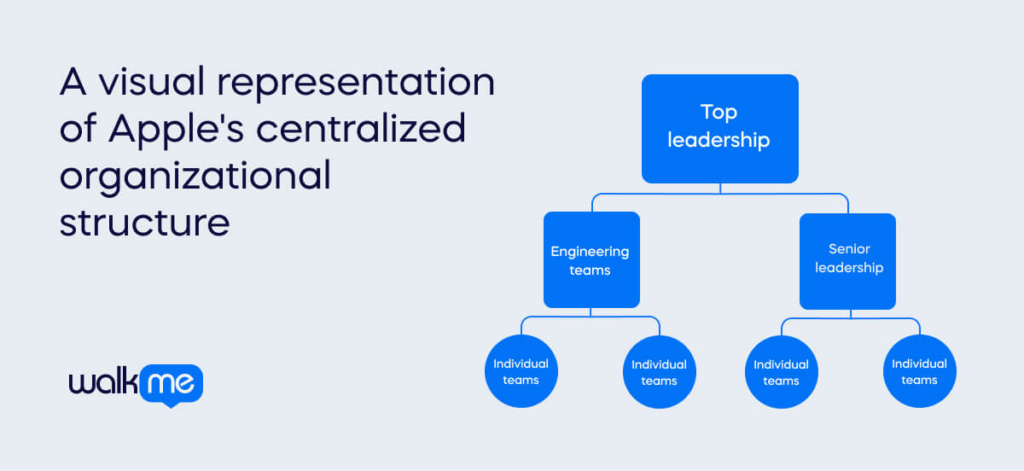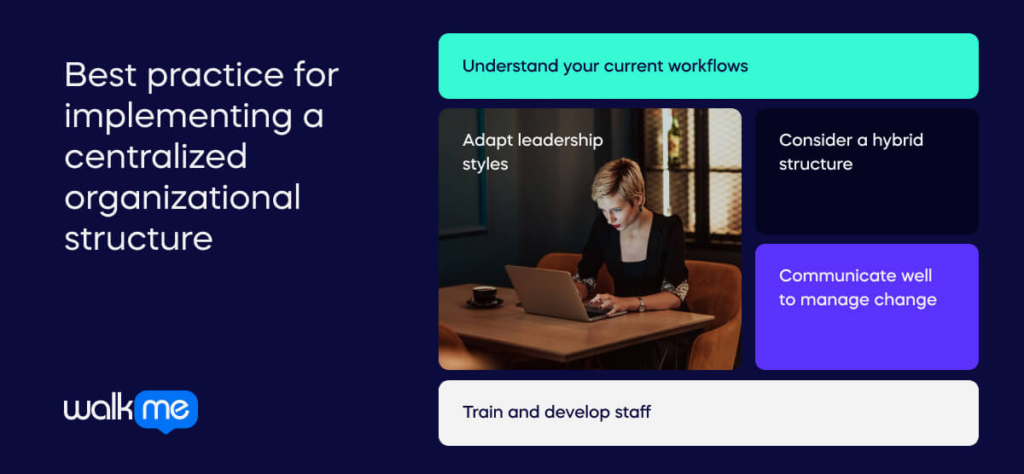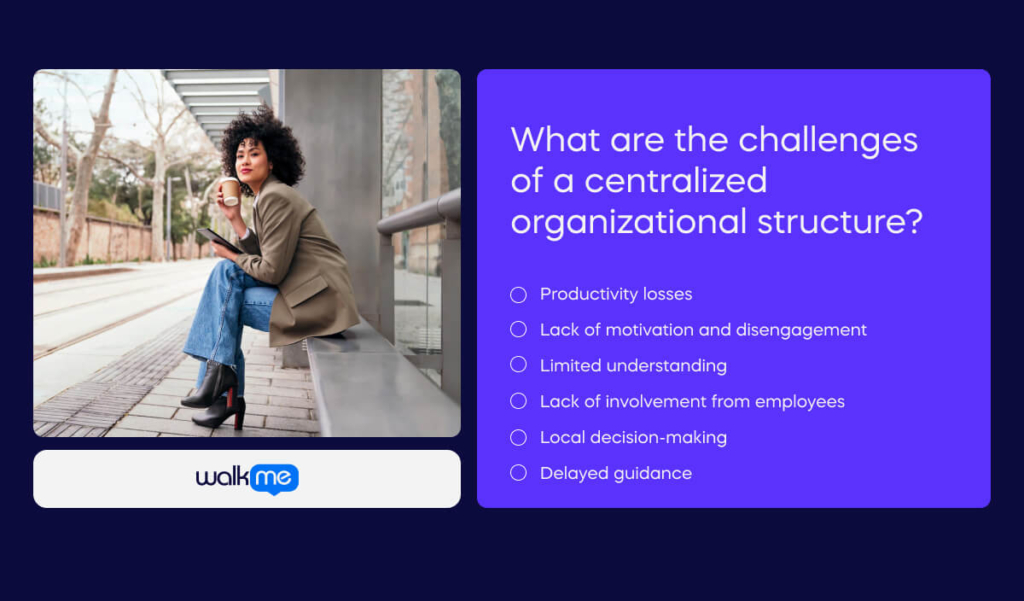Organizational design aligns structure, roles, processes, and culture with goals and environment. Forward-looking design anticipates future needs and growth. It ensures the structure can expand without losing efficiency or core values.
A well-designed organization inspires confidence. Stakeholders like investors and regulatory bodies see the commitment to governance and growth.
A key decision is whether to adopt a centralized structure. Centralization concentrates planning and decision-making in one leader or location. The head office directs all locations. In this way, it creates top-down communication.
This article will explore what centralized structures are. We’ll see how they differ from decentralized ones. We’ll also look at the benefits, challenges, examples, and best practices.
What is a centralized organizational structure?
A centralized organizational structure puts management and decision-making at the top.
It focuses on coordinating financial, human, and other resources. A senior leader handles strategic planning, goal setting, budgeting, and talent acquisition.
Centralized management suits companies focused on manufacturing and cutting costs. It promotes department teamwork, streamlines practices, and coordinates with outside partners. This traditional structure is common in older and smaller businesses.
What is the difference between a centralized and decentralized organizational structure?
In a centralized organization, decision-making power and authority are at the top. Lower levels follow the directives and policies of upper management.
In a decentralized organization, decision-making power and authority are among the lower levels. Upper management provides guidance and support.
Both structures have pros and cons. Their effectiveness depends on the size, complexity, and organizational goals.
Through this grid, we will explore their differences:
| Centralized | Decentralized | |
| Control | Strict control and supervision by management | More autonomy as all employees can make decisions. |
| Adaptability | Standardized, consistent policies and procedures | Policies and procedures are adaptable to change |
| Decision-making power | Comes from the top, meaning decisions are slower | Spread out across levels, meaning decisions are faster |
| Flow of communication | Top-down | Bottom-up or horizontal |
| Morale | Low due to less autonomy when it comes to decisions | High as employees can make decisions at any level |
| Customer experience | Less responsive | More responsive as employees can take the initiative to solve issues. |
What is an example of a centralized organizational structure?

Apple exemplifies a highly centralized approach. Top leadership makes critical decisions regarding product design, software features, and hardware specifications. This ensures a meticulously crafted user experience across all Apple devices, from iPhones to MacBooks.
Within this structure, engineering teams function with a clear hierarchy. Senior leadership dictates project goals and timelines. While some collaboration exists, individual teams primarily focus on executing these pre-determined plans.
This centralization offers advantages like tight control over product quality and a unified brand image. However, it can stifle innovation as lower-level engineers have less opportunity to contribute ideas or adapt to emerging trends.
Additionally, decision-making can be slower as technical specifications need approval from senior leadership before implementation.
Best practice for implementing a centralized organizational structure

To decide if a centralized organizational structure is best, have a look at these tips:
Understand your current workflows
To determine the best structure for an organization, start by understanding the critical workflows. Form follows function.
For example, a leader assessing the best structure for existing product development should begin by identifying all functions involved in this process. Next, consider the nature of the work each function performs. This analysis helps decide the best coordination approach for each function.
Adapt leadership styles
Leaders must adapt their styles to manage change and innovation.
In centralized organizations, leaders should be directive, authoritative, supportive, and communicative. They should define goals and expectations, involve employees in decision-making, provide feedback and recognition, and encourage employees to take initiative.
This is the opposite of decentralized businesses. In decentralized organizations, leaders should be participative and democratic. They must also be strategic and visionary—delegate authority and responsibility to managers and employees.
Provide guidance and direction, encourage collaboration and innovation, and ensure alignment with the organization’s mission and values.
Consider a hybrid structure
Identify which functions to centralize or not for optimal efficiency and effectiveness.
Choose functions that benefit from economies of scale and standardization. These include technology, distribution, loyalty programs, travel trade sales, and marketing. Centralizing these functions ensures consistency.
It streamlines logistics. It maintains uniformity. It improves efficiency. It ensures a unified brand message.
Decentralize functions that need local knowledge and customization. These include demand analysis, local sales and marketing, and operations of restaurants and facilities. Local teams better understand specific market demands. They tailor efforts to regional preferences. They manage operations with flexibility.
Communicate well to manage change
Effective communication is crucial for managing change and innovation in centralized organizations.
In centralized organizations, focus on the rationale and process behind changes. Communicate the reasons for change and the steps involved.
Use both formal and informal communication channels. Keep communication frequent and open. Encourage employee feedback and respond to concerns.
In decentralized organizations, focus on vision and roles. Communicate the vision, goals, and roles. Use a variety of communication methods. Show trust and respect in team decisions.
Train and develop staff
Training and development are crucial for all employees. Provide continuous learning to develop necessary skills. Check performance often using key performance indicators (KPIs).
Focus on adaptability to handle future changes and innovations. This ensures that you prepare employees to perform in centralized roles.
What are the benefits of a centralized organizational structure?
The various benefits of a centralized organizational structure include:
Vision and focus
Good leadership needs vision. A centralized structure keeps everyone aligned. The president or executive team sets and shares the vision, keeping things consistent and clear. This helps deliver a unified message to customers and communities. When everyone works toward the same goal, the organization runs better.
Efficiency and standardization
Centralization brings efficiency through economies of scale and standard processes. It helps manage costly technology and data reliance. By cutting redundancy, centralized organizations streamline their work. One IT department managing technology saves time and resources.
Risk management
Centralized decision-making controls and manages risk better. With fewer decision-makers, it’s easier to stay aligned and make solid decisions. This setup is ideal for reducing and managing risks. Fewer people in the process mean quicker, clearer responses to risks.
Clear hierarchy
A clear hierarchy ensures efficient decision-making. Everyone knows who to report to and where to go with questions. Senior executives delegate authority, avoiding overlap. This clear chain of command helps execute decisions in a swift and uniform manner.
Collaboration and quick responses
Centralization boosts cross-functional collaboration. Fewer people discuss and decide on strategy, allowing quick reactions to market changes. Leaders gather information and discuss options in small groups. This speeds up communication and decision-making compared to decentralized structures.
Talent utilization
Centralization better uses talent and supports specialized skills. It enables an internal creative community and culture with a clear line of authority. Standard procedures cut office and administrative costs. Central decisions are communicated outward, saving the organization from hiring specialists. Clear command reduces duplicate responsibilities and extra fees.
Consistency and reduced conflict
Centralization ensures consistency across channels and audiences. It delivers a unified brand message and consistent customer experience. Fewer decision-makers reduce conflict and dissent among employees. Top managers handle critical decisions, shielding others from risky or unpopular choices. This setup helps maintain good manager-employee relationships.
Faster decision making
Centralized decision-making speeds up the process. A small group makes decisions and communicates them quickly. This streamlined approach means faster implementation and benefits the whole organization. Quick, efficient decisions help the organization respond to market changes and internal challenges.
Clear roles and responsibilities
Employees have well-defined job descriptions and roles within a centralized structure. Employees who understand all duties are more productive and confident in their responsibilities.
Boosted morale
Clear roles help improve morale. Workers are less likely to resent each other for overstepping boundaries or not working hard enough. This clarity creates a more positive work environment.
Efficient management
Defined responsibilities make it easier for management and HR to assess the need for new roles or hires. This avoids redundant hires and keeps costs down. It also helps in recruiting qualified workers for essential positions.
What are the challenges of a centralized organizational structure?

But, there are also challenges of using a centralized organizational structure, which are:
Productivity losses
Centralized communication can lead to significant productivity losses. In a centralized system, employees depend on information from the top. This reliance means that if the flow of information is slow, employees may spend long periods waiting for instructions.
During these waiting times, productivity drops. Employees are unsure of their next steps. Bottlenecks can form when too many employees need guidance at the same time, causing further delays. The result is a less agile workforce that cannot respond to immediate needs or changes.
Lack of motivation and disengagement
Centralized decision-making can result in low employee morale and disengagement. Employees may feel undervalued when decisions are made without involving those who will execute them. This creates a gap in alignment between leadership and staff.
Employees may see decisions as disconnected from their daily work. The lack of transparency about decision factors worsens this issue. Over time, morale decreases. Employees feel less ownership. They have less responsibility for their work outcomes.
Limited understanding
Centralized decision-makers often lack a detailed understanding of business units. Central leadership focuses on overarching strategies. They may not grasp specific challenges and opportunities. You should align resources to business units to aid understanding.
This helps gain in-depth knowledge of their operations, products, and services. Not all skill sets need such alignment. Specialized technical skills might remain centralized. Customer-facing roles may benefit from closer alignment with business units. This approach helps bridge the knowledge gap. You can make decisions based on a fuller understanding of the business landscape.
Lack of involvement from employees
Centralized decision-making restricts employee involvement in shaping decisions. When you make decisions at headquarters, employees at other levels become mere implementers. This exclusion stifles creativity. Those involved in day-to-day operations can identify innovative solutions.
The lack of involvement leads to reduced performance and motivation. Employees not engaged in decision-making may feel undervalued. When implementation difficulties arise, senior executives may not understand the challenges. They are not directly involved in execution.
Local decision-making
Individuals closest to the action or problem often make the best decisions. They understand the context, environment, and specific issues at hand. Decentralized decision-making empowers local managers and employees. They can act based on firsthand knowledge.
Centralized decision-making can be riskier. It relies on the intuition and limited understanding of a few top leaders. These leaders may not have the nuanced insights needed for every situation. This can lead to less informed and less effective decisions.
Delayed guidance
Centralized communication systems often result in employees waiting long periods for guidance. This delay hampers employee productivity. Workers depend on a top-down flow of information to proceed with their work. In a fast-paced business environment, delays can be costly. Projects stall, and you can miss opportunities.
Employees are not empowered to make their own decisions. This waiting game frustrates employees. It creates inefficiencies that ripple through the organization. It also affects their performance and competitiveness.
Key takeaways for a centralized organizational structure
Organizational structure is the workflow system that directs task allocation, coordination, and supervision. It helps achieve an organization’s goals. This structure provides clarity and direction. It also promotes smooth communication.
The two types of organizational structures are centralized and decentralized. In centralized organizations, decision-making power is at the top. In decentralized organizations, decision-making power is spread across different levels and departments.
The main elements of an organizational structure include job design and departmentalization. It also considers the chain of command, span of control, and delegation. These elements balance efficiency, control, and flexibility. They encourage clear communication, accountability, and employee engagement.
Choosing between centralization and decentralization requires understanding the organization’s strategy, size, culture, technology, and employee experience.
It also requires knowledge of the external environment. The key is finding the right balance between control and flexibility. The chosen structure should help achieve goals while staying responsive to market changes.
Recognizing the benefits and limitations of each approach helps organizations make informed decisions. Each structure presents challenges, but alignment with strategic goals is crucial.
A well-informed choice in organizational design leads to effective communication, streamlines decision-making, drives efficiency, innovation, and growth, and results in long-term success.


